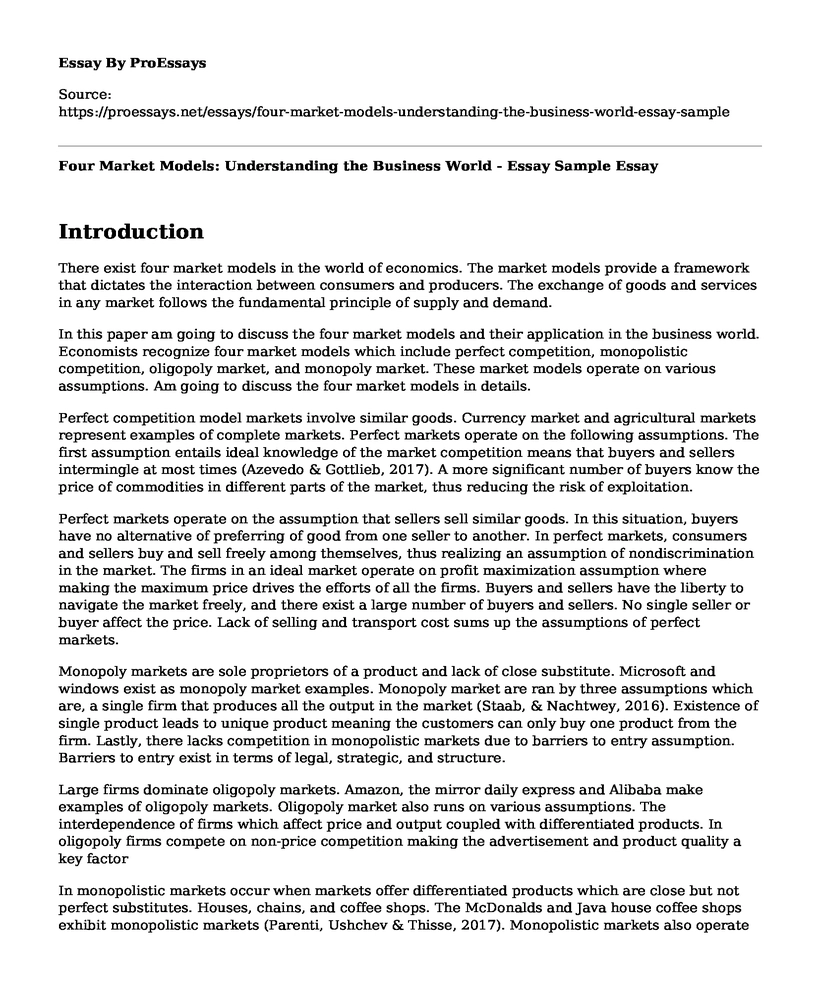Introduction
There exist four market models in the world of economics. The market models provide a framework that dictates the interaction between consumers and producers. The exchange of goods and services in any market follows the fundamental principle of supply and demand.
In this paper am going to discuss the four market models and their application in the business world. Economists recognize four market models which include perfect competition, monopolistic competition, oligopoly market, and monopoly market. These market models operate on various assumptions. Am going to discuss the four market models in details.
Perfect competition model markets involve similar goods. Currency market and agricultural markets represent examples of complete markets. Perfect markets operate on the following assumptions. The first assumption entails ideal knowledge of the market competition means that buyers and sellers intermingle at most times (Azevedo & Gottlieb, 2017). A more significant number of buyers know the price of commodities in different parts of the market, thus reducing the risk of exploitation.
Perfect markets operate on the assumption that sellers sell similar goods. In this situation, buyers have no alternative of preferring of good from one seller to another. In perfect markets, consumers and sellers buy and sell freely among themselves, thus realizing an assumption of nondiscrimination in the market. The firms in an ideal market operate on profit maximization assumption where making the maximum price drives the efforts of all the firms. Buyers and sellers have the liberty to navigate the market freely, and there exist a large number of buyers and sellers. No single seller or buyer affect the price. Lack of selling and transport cost sums up the assumptions of perfect markets.
Monopoly markets are sole proprietors of a product and lack of close substitute. Microsoft and windows exist as monopoly market examples. Monopoly market are ran by three assumptions which are, a single firm that produces all the output in the market (Staab, & Nachtwey, 2016). Existence of single product leads to unique product meaning the customers can only buy one product from the firm. Lastly, there lacks competition in monopolistic markets due to barriers to entry assumption. Barriers to entry exist in terms of legal, strategic, and structure.
Large firms dominate oligopoly markets. Amazon, the mirror daily express and Alibaba make examples of oligopoly markets. Oligopoly market also runs on various assumptions. The interdependence of firms which affect price and output coupled with differentiated products. In oligopoly firms compete on non-price competition making the advertisement and product quality a key factor
In monopolistic markets occur when markets offer differentiated products which are close but not perfect substitutes. Houses, chains, and coffee shops. The McDonalds and Java house coffee shops exhibit monopolistic markets (Parenti, Ushchev & Thisse, 2017). Monopolistic markets also operate on various assumptions. The similarity but indistinctiveness of product makes the best assumption in a monopolistic market. Due to monopolistic competitiveness, there exist barriers to entry and exit in the market. Other assumptions include less pricing power, a large number of sellers, product differentiation, and non-price competition.
The four market models earn long-run profit differently. The perfect market makes a long-run profit when the total revenues exceed the total cost, thus attracting outer firms in the industry while in monopoly competition, long-run profit occur when marginal cost equals marginal revenue. The level of benefits depends on the degree of competition. In oligopoly market profit, in the long run, dictates that minimal cost must equal the marginal revenue while in monopolistic market profit, in the long term, equals total revenue minus total cost. A government needs to regulate a monopoly from time to time through the concept of the patent because if patents never existed someone who invested time and money to make invention would not get income on a precious device when other people imitates the invention.
References
Azevedo, E. M., & Gottlieb, D. (2017). Perfect competition in markets with adverse selection. Econometrica, 85(1), 67-105.Retrieved from https://eduardomazevedo.github.io/papers/Azevedo%20and%20Gottlieb%20-%20Competition%20with%20Adverse%20Selection.pdf
Parenti, M., Ushchev, P., & Thisse, J. F. (2017). Toward a theory of monopolistic competition. Journal of Economic Theory, 167, 86-115.Retrieved from https://dial.uclouvain.be/pr/boreal/object/boreal%3A152387/datastream/PDF_01/view
Staab, P., & Nachtwey, O. (2016). Market and labor control in digital capitalism. TripleC: Communication, Capitalism & Critique. Open Access Journal for a Global Sustainable Information Society, 14(2), 457-474.Retrieved from https://www.triple-c.at/index.php/tripleC/article/view/755/888
Cite this page
Four Market Models: Understanding the Business World - Essay Sample. (2023, Feb 13). Retrieved from https://proessays.net/essays/four-market-models-understanding-the-business-world-essay-sample
If you are the original author of this essay and no longer wish to have it published on the ProEssays website, please click below to request its removal:
- Analysis of the Risk and Value Implication for Capital Structure Issues Essay
- Better Drinks Company Marketing Analysis Paper Example
- Characteristics of Toyota Company Paper Example
- High-Tech Drug Production: Impact on Global Supply Chain - Essay Sample
- Essay Sample on Maximizing Employees for Organizational Success
- Essay Example on Bad Customer Service? Here's How to Fix It
- Paper Example on Social Hierarchies and Their Impact







